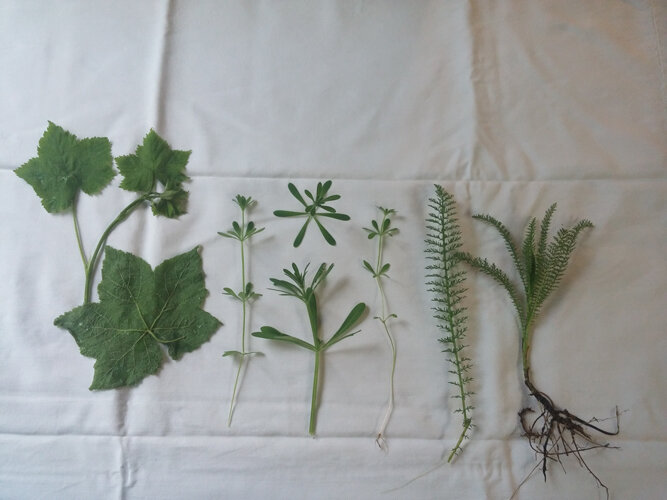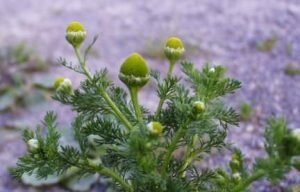 From left to right: thimbleberry, cleavers, yarrow.
From left to right: thimbleberry, cleavers, yarrow.For many, summer is a time to relax, slow down, and enjoy the warm season of our lives. One way I’ve found to enjoy these months while slowing my roll is to incorporate fresh foraged plants into my tea-drinking habit. I take a walk, find plants for my tea, watch their growth and then thank them as I drink them.
The plants listed here are those I use for fresh summertime tea, but they can also be dried and stored – just set your dehydrator to low and dry the plants whole. Once completely dry, pack them into an airtight container and store in a dark space.
When making herbal tea, bring water to a boil, turn off the heat, add your plant material, and cover to steep for 15-60 minutes, depending on your taste, time constraints and what you think the plant needs. Steeping this long releases more nutritive components of the plant, while covering keeps evaporative aromatic oils contained until things cool down.
Cleavers (Galium aparine)
Found in shady, loose soil, this plant is known for it’s Velcro-like quality. It grows like a loose bottle brush tipped with white flowers. It is generally regarded as a tonic – a plant we can use over time to restore and improve our bodies’ natural functions and promote general well being. It is a mild diuretic with cooling, anti-inflammatory and astringent properties. It is commonly used for soothing lymph, urinary and skin irritations.
 Pineapple Weed (Matricaria discoidea)
Pineapple Weed (Matricaria discoidea)
This plant pops up on the compacted edges of disturbed gravel and dirt patches. When crushed, it gives off a faint scent of pineapple and chamomile (a close relative). It grows low to the ground with cone-shaped flower heads and lacy leaves. Pineapple weed is used to soothe upset stomachs, treat colds, intestinal and menstrual cramps and as a sleep aid. I find the flower heads are sweeter, while the leaves will increase the bitterness of your tea slightly.
Thimbleberry (Rubus parviflorus)
These bright green, maple-like, soft leaves are a lovely addition to an herbal tea. Harvest leaves sparingly before the plant sends up white flowers. After flowering the plant focuses on making berries, so let it be. The tea is a gentle anti-nausea aid, a uterine restorative and strengthener and it is mildly astringent.
Yarrow (Achillea millefolium)
With pancake- to umbrella-shaped clusters of tiny white flowers and long, feathery leaves, yarrow is a common sight in the Pacific Northwest. Harvest the leaves after the flowers appear for a fresh-scented tea that can lower fevers by inducing sweating and internally lowering body temperature. It’s great for uterine health, and can help to regulate bleeding. It is anti-inflammatory and astringent, and promotes the movement of mucus inside the body. Leftover tea makes a great hair rinse, as well!
Coastal Mugwort (Artemisia suksdorfii)
Mugwort grows in a powerful way – erect stalks that produce dark green, ragged leaves. The leaves’ underside has a downy sheen and in mid-summer the flowers form a spike-shaped cone. Pick the scented leaves before the plant blooms, and start out sparingly with the strength of your tea. It is a diaphoretic and an expectorant, meaning it will induce sweating and help expel mucus from your body. It’s also used to stimulate the digestive, urinary and uterine systems. Mugwort is calming to the body and mind and can stimulate lucid dreams. This plant contains thujone, which should not be taken in large doses or while pregnant. It is wise to drink this tea sparingly and with a purpose, a few days in a row at most, with a week or more between uses.
Before you start picking, get out your plant identification book and do some research. This article is intended to give you ideas for plants to get started with. It's up to you to know what you can ingest and what to avoid. Remember to be absolutely positive about your identification before picking.
Harvest responsibly! Only pick what you will use, never harvest more than one-fifth of a plant and leave no trace in the woods. Check your surroundings for toxic runoff, chemical sprays and high-traffic areas and avoid harvesting in these areas.
These plants, which are easily found in our area, can lead you to many different natural environs. Relax and enjoy your hiking and harvesting!
Looking for other things to add to your cup, or don’t have time to jump into nature?
Wonderland Tea and Spices
1305 Railroad Avenue
Bellingham, WA
360/733-0517
Living Earth Herbs
1530 Cornwall Avenue #102
Bellingham, WA
360/734-3207
Gaia Garden Herbal Dispensary
2672 W Broadway,
Vancouver, BC
604/734-4372
Amy Gibson loves learning about all the edible and medicinal plants she can find in Whatcom County.